Introduction
The trills of the virginal are vibrant, strong, and not easily forgotten. A virginal is a small, rectangular box-shaped plucked string keyboard instrument with a forty-five-note, C/E to c3, compass, and strings made of wound brass or iron.1 It is distinguished from other keyboard instruments of the time because the strings run on the horizontal axis, meaning they are oriented perpendicular to the keys.2 The virginal became popular throughout the low countries during the late sixteenth century. Traditionally, the body of the instrument was often decorated with painted scenes (often featuring a landscape) or repetitive motifs, while the interior had colorful flowers and songbirds floating beneath the strings. The painted wood or bone keyboards were placed in the center or far right of the soundbox, and their placement determined the plucking point of the instrument’s jacks which in turn affected their sound. In an obvious majority of seventeenth-century Dutch paintings portraying virginals, they are being played by women. While paintings cannot be assumed to exactly replicate life, this extraordinarily high percentage leads one to assume that the overwhelming number of female virginal players in the visual record corresponds to some degree to the musical practice.3 The instruments portrayed are not only visually impactful, they also represent musical potential which could be most readily accessed by trained, feminine audiences.
There are two primary models of virginals produced in the seventeenth century. A spinet virginal (not to be confused with a spinet, a portable keyboard instrument), has the keyboard positioned on the left of the soundbox. This construction places the plucking close to the end of the strings creating a sound that musicologist Grant O’Brien (b.1940) describes as “pointed and insistent.”4 When the keyboard is located towards the right-hand end of the case, the instrument is referred to as muselar virginal, and the timbre of this model is developed and enriched by the deep chest-like soundbox.5 The position of the keyboard and jacks makes the plucking point of the strings closer to the center, giving muselar virginals a discernibly different sound that can be described as flute-like.6 When a note is struck, the tone is rich which allows for beautiful melodic layering. As the sound hangs in the air there is a distinct hum of the string’s metallic vibrations rippling out.7
The acoustic relevance of these instruments has not yet received much focus from art historical scholarship where female musicians tend to be interpreted as iconographic objects, rather than music-making subjects. In her entry for the 1994 Hoogsteder exhibition, “Music and Painting in the Golden Age,” art historian Magda Kyrova interprets female musicians as symbols of marital harmony, temperance, and allegorical representations of ‘hearing’; however, the acoustic space and the musical accomplishments of women in them are absent from her analyses.8 In the later 2017 “Vermeer and the Masters of Genre” exhibition, art historian Marjorie Weisman acknowledges the musical skill of young musicians in “Inviting Duets,” but her interpretation primarily discusses the young women’s role as flirtatious sirens, harkening to an assumed male audience for a duet.9 On the other hand, in the discipline of musicology, the visual record is not considered a source. The Introduction of Cultural History of Noise, Sound, and Listening (2017) lists literature, treatises, scientific writings, newspapers, letters, diaries, account books, legislative documents, musical scores, civic records, and parish registers as primary sources for recovering historical music but paintings, indeed any pictorial record, is absent.10 The intersection of music and visual culture within the musicology field is referred to as “Musical Iconography,” which faces many of the issues addressed in iconographically-focused art history in regards to a lack of multisensory analysis.11 By examining how both womanhood and music were understood in the Dutch seventeenth century, this article explores how female viewers may have embodied these painted performances by virtue of their musical training.12
Music and noise were fundamental to the organization of one’s day in the early modern period, and women of the middle and upper classes would have inhabited a separate soundscape from their male counterparts.13 Women were not barred from or unaware of the public soundscape, but they did not have the same level of agency beyond the threshold of their homes. In public settings, their virtues would have been considered under threat by music and other stimuli that were perceived as being beyond their control. In the domestic setting, women had the authority to cultivate an atmosphere that satisfied every one of their senses while adhering to the cultural compulsion for “safety.” Art historian Elizabeth Honig suggested in her essay, “The Space of Gender in Seventeenth-Century Dutch Painting,” that artists recognized a market for female buyers and composed domestic scenes to appeal to their gaze.14 It stands to reason that sight was not the only sense an artist could call upon to connect with a feminine audience.
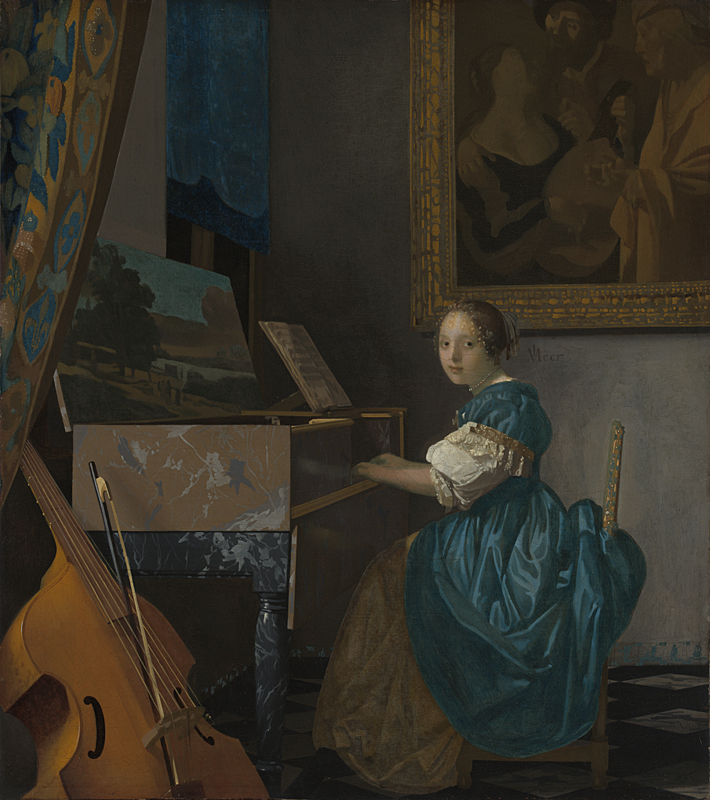
Johannes Vermeer’s (1632-1675) A Young Woman Seated at a Virginal (1670-72, fig. 1) demonstrates a majority of the stylistic components, as well as the phenomenological and sociocultural elements, of what I propose were paintings that spoke to the “feminine ear.” Vermeer offers his viewers a glimpse into a domestic and deeply private space. There are no visible cues from the public world. The doors and windows are either out of the frame or hidden in the shadowy recesses of the space, enhancing the sense of intimacy between viewer and performer. To enter the space, the viewer must pull back a curtain, which allows a golden light to catch the planes of a picture frame and fall like a theatrical spotlight onto the central figure, a young musician in an opulent dress engaged in playing a colorful and elaborately decorated virginal. The musician beckons us in not only with a glance but also with the tune unfolding beneath her fingers. Her hands appear in a luxurious haze over the keyboard, perhaps a visible embodiment of the ephemeral notes she releases into the soundscape. The highly decorated instruments resemble those of the Rucker’s Family, a famed Antwerp family of instrument builders. A virginal by Johannes Rucker’s (1578-1642), currently the Metropolitan Museum of Art’s collection (1622, fig. 2), is exemplary of their typical construction. In the shallow encasement beneath the lid, the virginal’s strings, now memorialized in score marks on the wood, run parallel to the wooden frame. The frame is decorated with intricate damask motifs, which weave around the exterior like tangled vines. Smaller designs rise above the lip of the soundbox, leading the eye to the moralizing Latin inscription emblazoned on the open lid. At the far right of the instrument are wooden pegs to which the ends of the strings were attached and could be tuned.
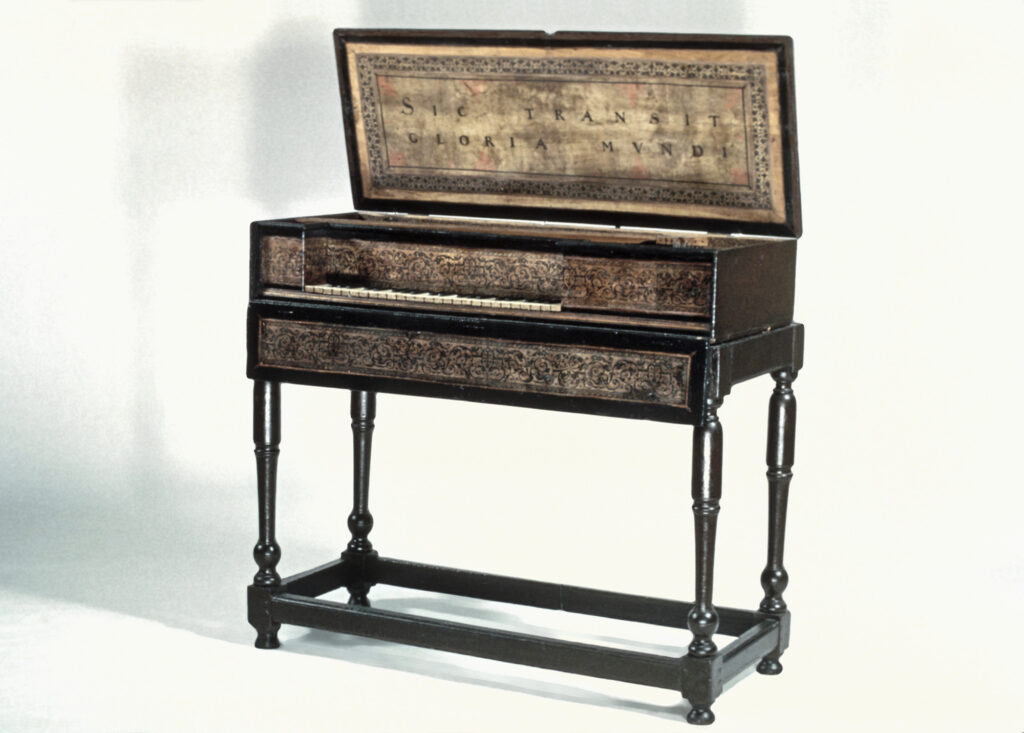
As depictions of musical instruments and musicians expanded in the Dutch Republic during the second half of the seventeenth century, musical performance continued to operate within tenuous social regulations that had been established in the previous centuries. On the one hand, it appears to have been an accepted exercise in the praise of the Lord, further extolled by the mottoes on painted and physical instruments. At the same time, it was viewed as an instrument of vanity and the vita voluptuosa (voluptuous life) feared by Calvinist writers and moralists.15 These teachings emphasize the sovereignty of the Lord and the authority of the Bible. Original musical compositions from the Netherlands pale in comparison to neighboring countries during this period, primarily due to the Calvinist belief that music was a worldly pleasure and should be regarded warily.16 Despite these hindrances, the genre of musical painting flourished. The 1994 Hoogsteder exhibition in The Hague entitled “Music and Painting in the Golden Age,” demonstrated that ten percent of all seventeenth-century Dutch paintings included music in some form.17 Within a limited oeuvre, the popularity of the genre becomes strikingly clear. Johannes Vermeer painted seven music-making scenes within his total of thirty-four identified works. Vermeer’s composition participates in a trend that enraptured artists from all seven provinces of the Dutch Republic. Comparatively, twenty percent of Frans van Mieris’(1635-1681), twenty-five percent of Pieter de Hooch’s (1629-1684), and almost half of Jacob Ochtervelt’s (1634-1682) paintings show music making in some capacity.18
Music in the Dutch Republic
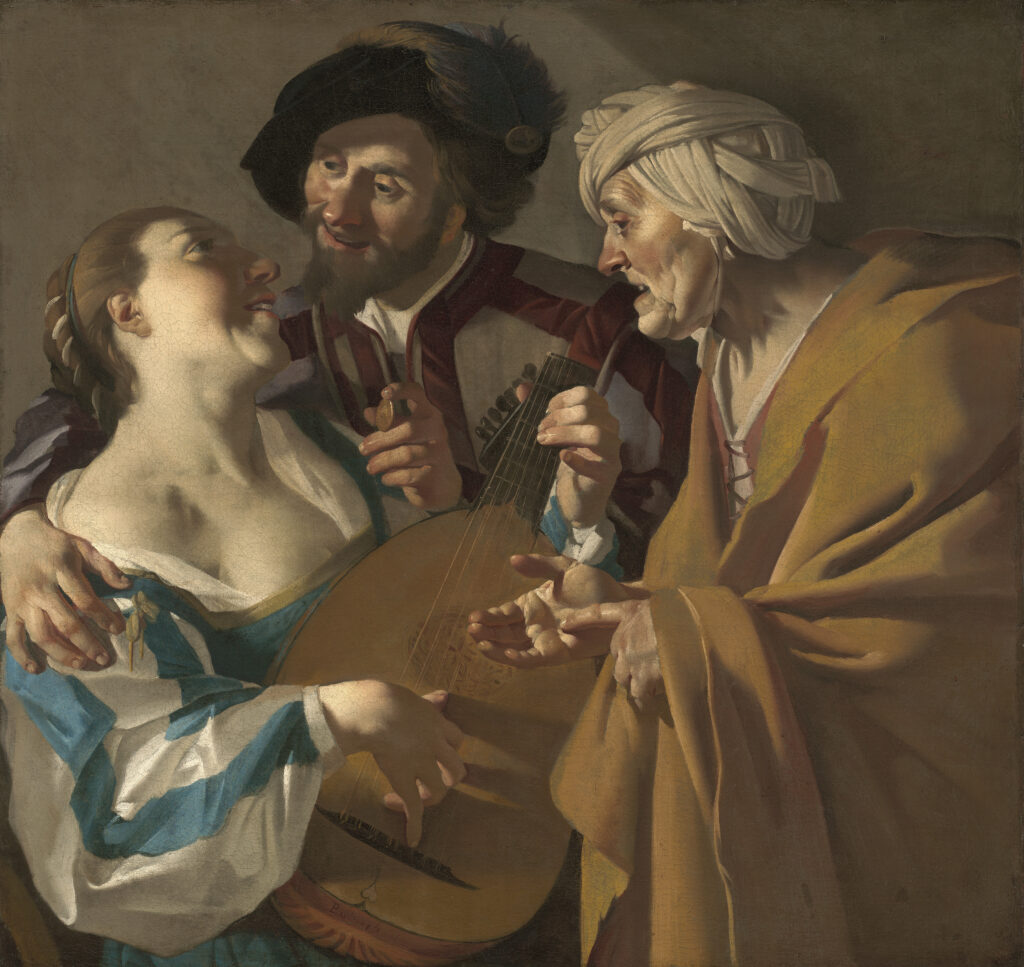
Dutch artists of the seventeenth century often created and participated in visual trends, such as smoking soldiers and window niche scenes, that were distinguished from the religious-centric trends of neighboring European countries. They utilized these trends partially to adapt to the open market and also to ensnare the thoughtful eyes of liefhebbers (connoisseurs).19 Representations of female musicians were a visual trend that was especially prominent in Dutch art in the second half of the seventeenth century. The popularity of the subject could be linked to a growing female audience, who were drawn to musical works because the subject resonated with their lived experiences.20 Of all the instruments depicted in the seventeenth century, the virginal has the most overt feminine associations.21 Vermeer’s young virginal player (fig.1) portrays the societal role of an upper-class woman. Sitting on a stage of sorts, bathed in the soft haze of an unseen light, she regards her audience with a tender, if somewhat hesitant, gaze. Adorning the soundboard of her virginal are the soft cascading hills of a landscape, while, on the exterior, strokes of vivid blue paint visually link the instrument to the gown of the musician. Her solitary performance is seemingly interrupted by the viewer who has entered her space. Her fingers still linger on the white keys, indicating some sweet notes that may be rippling out around her. Behind the virginal player hangs a copy of a Dirck van Baburen (1595-1624) painting titled The Procuress (1622, fig. 3), owned by Vermeer’s mother-in-law, Maria Thins (c. 1593 -1680). Pictured against a backdrop of darkness, the lutenist cradles the instrument close to her voluminous and nearly bare breasts. A man leans in, captivated by the sensual offerings of the musician, only to encounter the wrinkled hand of a matron demanding payment for the performance and perhaps a private reprise.
The juxtaposition of elegant virtuosity and provocative performance in Vermeer’s work profoundly encapsulates the perceived duality of music in the Dutch Republic. Calvin cautioned that music:
[….] should not be the occasion of our giving free rein to dissoluteness or of making ourselves effeminate with disordered pleasures and that it should not become the instrument of lasciviousness or of any shamefulness…Wherefore [one] must be the more diligent in ruling it in such a manner that it might be useful […]and in no way pernicious.22
At the Synod of Dordrecht in 1574, an assembled council of Calvinist leaders preserved this sentiment into law. Among other regulations, the Synod outlawed the instrumental, typically organ, accompaniment of congregational singing in churches. The sound of unaccompanied singing was commented on by the statesman, writer, and lay musician Constantijn Huygens (1596-1687), who wrote of unaided voices: “Among us this more often sounds like wailing or screaming than human singing. The tones sound dissonantly through each other like birds of different beaks.”23 The Synod’s edict greatly impacted the character of Dutch music because, like art, it required pivoting toward secular expression.
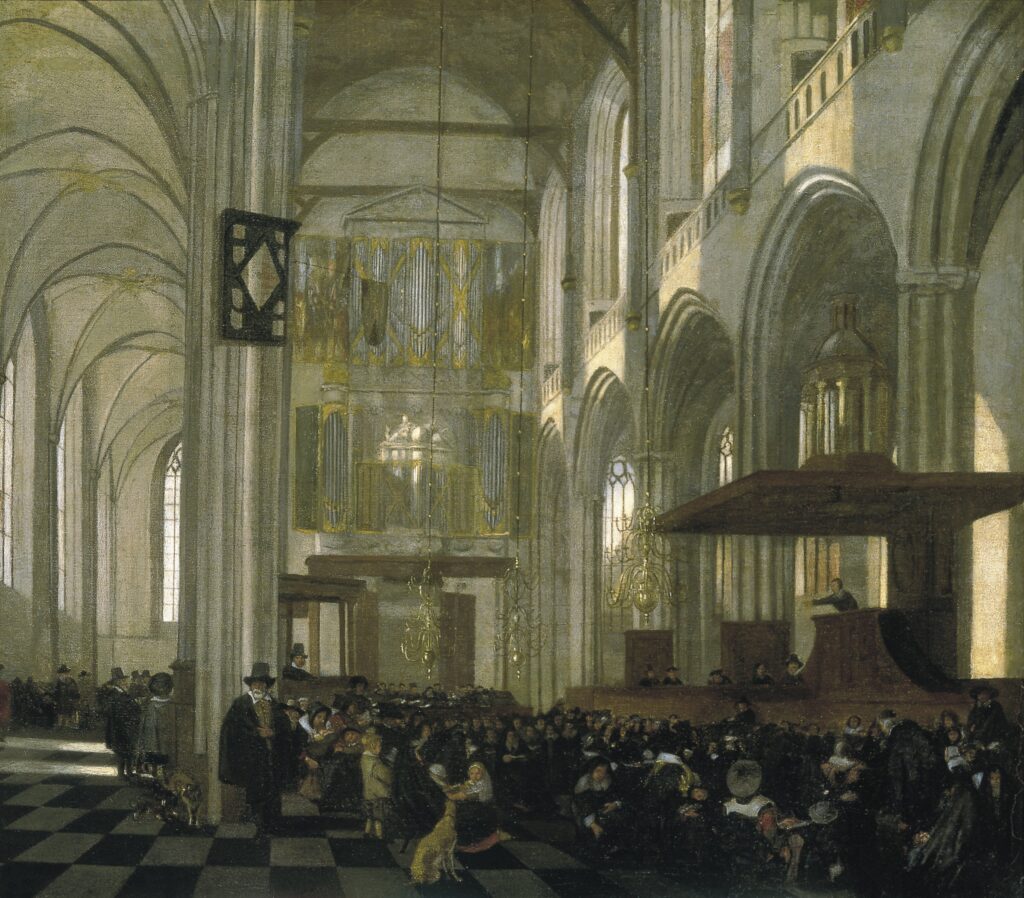
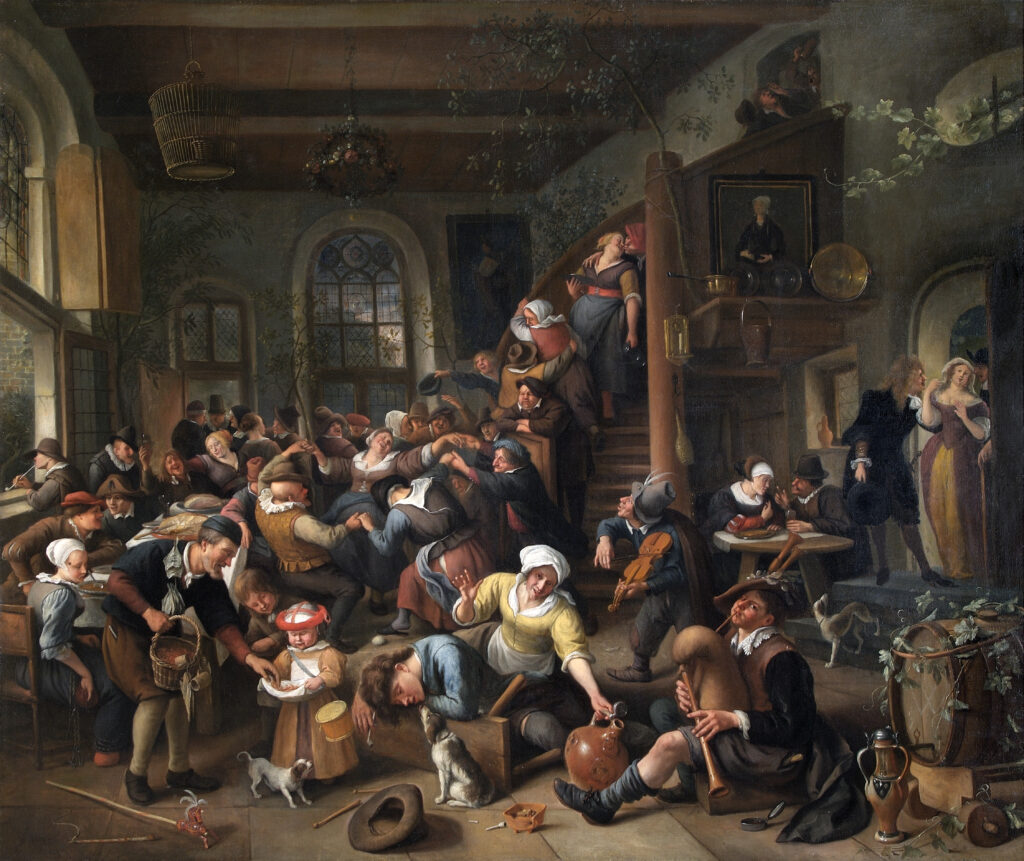
City-employed organists, one of many salaried positions available for musicians in Dutch cities, were often contracted to give weekly secular concerts.24 While organs no longer served a religious function, they remained in most of the major churches. One can see a particularly excellent example in Emanuel De Witte’s (1617–1692) Interior of the Nieuwe Kerk, Amsterdam, during a Service (1660, fig. 4). While the rest of the Nieuwe Kerk has been stripped of excessive decoration, in adherence to staunch Calvinist standards, the gold embellishments and silver pipes of the large organ still gleam from the back wall above the austerely dressed congregation.25 The contract for Leiden’s city organist states that organ concerts were a respectable diversion to keep people out of inns, taverns, and pleasure gardens where they might encounter more corrupting melodies.26 Establishments called muziekherbergen (Music Inns) and danskamers (Dance Rooms) often hosted traveling musicians and customers who were cajoled into performing for their drink.27 In cities with no public musical venues, these spaces were centers for music life for patrons of all backgrounds.28 The owner of the famed Os in de Bruiloft (Ox in the Wedding), also known as Huis te Sinnelust (House of Pleasure), welcomed awed visitors into a musical paradise filled with instruments, music boxes, fountains, and mechanical waterworks.29 Artists like Jan Steen (1626- 1679) captured the chaotic and lascivious atmosphere of these festive places in his composition The Egg Dance (ca. 1670, fig. 5). Music appears to be the artery of the Egg Dance venue, pulling people in through the wide-open doors, as it would have done for many such establishments in the seventeenth century. Public music was typically dominated by bagpipes and viols, both visible in Steen’s jubilant bar, as well as rommelpots (clutter pot), and hurdy-gurdies.30 The latter instruments have a long history of ties to lower peasant classes.31
Women encountering music in these public places are typically depicted as vulnerable, pulled by music towards other vices. Some establishments employed, among other things, water jets hidden in the floor to purposefully spray unexpecting guests, often women, from below and wash away their stoic defenses.32 The abundant alcohol in the Egg Dance appears to serve a similar purpose. The foremost woman reaches for a drinking vessel, which is within eyesight of the bagpipe player whose cheeks flush red as he looks knowingly at the viewer. Standing above them, the viol player looks into the assembled crowd, admiring the work of his music as a woman loses herself in the dance; nearby, two couples have retreated to the stairs for romantic rendezvous. The women in these paintings represent the temptations lurking in public spaces that could be further inflamed by music. The reception and representation of public music have intrinsic connections to issues of social performance.33 When Dutch women conducted musical affairs in public spaces, testing the boundaries of their gender, they were met with fears of promiscuity. These social fears were then exacerbated by artists and moralist writers to shore up the boundary. The Procuress (fig. 2), whose replica lurks behind Vermeer’s virginal player, is a stock character often seen in these musical venues. She is armed with a lute, which has a visual history as a tool for seduction.34 By placing the instrument in the arms of a woman, this power has also apparently been ceded. Van Baburen and many of his contemporaries who took on this subject may have seen fit to enhance the lutes’ more seductive association by having the instrument nestled closely to the women’s breasts, drawing the male figures’ eyes with a flash of pale skin. With the senses of their prey overstimulated, the lutenist, often with the assistance of a wrinkled matron, can upturn social norms and dominate the man in his sphere. The procuress type is a widely recognized female caricature of the early modern period. She embodies the cultural beliefs about seduction and music – emphasizing the immoral undertones that played out in the many public venues springing up across the rapidly urbanizing Republic.
Across the Threshold: The Soundscape of Domestic Spaces
Morality was the imperative behind the separation of space and regulation of behavior in Dutch society. Seventeenth-century theoretical writings on architecture and urban planning advocated separate zones within cities for different types of commercial enterprise and the division of trade and residential areas. Architectural practice showed the same stratification within the domestic environment.35 Philips Vingboons (1607-1678) was a sought-after architect of the upper classes of the Dutch Republic.36 The “typical” arrangement of a Vingboons home filtered the public world through the front room, a salon or zaal, where visitors would enter and be entertained. The back house, or achterhuis in Dutch, would contain more private spaces, such as the keukenhuis, room(s) where food is prepared, and the private rooms used only by the family and servants employed by the household. A later 1681 treatise by Willem Goeree (1635-1711) continued Vingboons’ classification of rooms by function with an emphasis on gendered division.37 As Goeree’s treaties states:
In almost all cases the foremost part of a house must be reserved for the man or house father, in order to house his shop, his office, his salet or consultation room, and his storage cellar etc. The woman or house mother has her quarters in and around the rear rooms where are also situated the cooking and living quarters, wash-house, and the rest of the things necessary for housekeeping.38
Domestic spaces in the seventeenth century, both in visual and historical records, were perceived as an orderly microcosm of the Dutch world.39 Because of this social construct, the appearance, organization, and function of the household carried substantial cultural weight. In Emanuel de Witte’s Interior with a Woman playing a Virginal (ca. 1660-67, fig. 6), the countenance of “appropriate” Dutch womanhood within the domestic space is visible. The two women are occupied by two equally industrious and feminine tasks, keeping the home clean and playing the virginal. A man is present but incapacitated and shrouded in the recesses of the four-poster bed. Feminine dominion over domestic space is substantiated by period travel documents. One such record, by Sir William Temple (1628-1699), describes Dutch women as tyrants of a sort, commanding the running of their households in ways that were foreign to his sensibilities.40 Honig offers visual evidence of this observation in her chapter, wherein she explains that in the typical domestic scene or genre image, men are absent, sometimes alluded to with a piece of masculine clothing or scene of the outdoor world to which they belonged.41 While men’s dominant economic and legal roles were codified in legislation, women were expected to maintain the domestic microcosm and therefore seemed to exert certain powers within the walls. In the left corner of De Witt’s painting, the silver handle of a sword catches a faint glint of sunlight, perhaps a nod to the unseen man’s profession. The sword represents rank and status in the masculine world; however, in the domestic realm, it serves a secondary function, as a meager audience to the women’s performance. In this way, visual and archival records substantiate that this internal sphere was understood as being in the purview of women.42
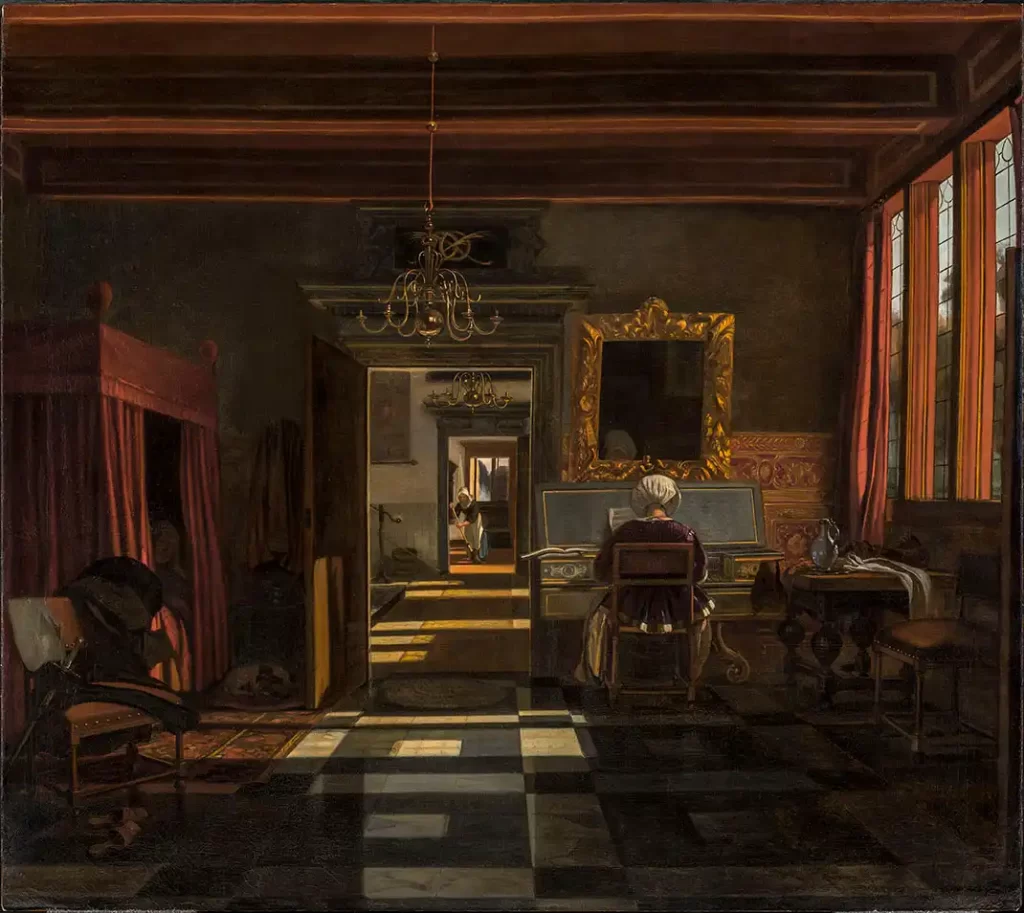
The extent of Dutch women’s independence is significant, especially considering the status of women in other European cities at the time. Women’s literacy levels in the Dutch Republic were comparatively high in the seventeenth century, as young women were encouraged to cultivate the skills necessary to maintain an efficient household.43 Evidence of this gendered expectation can be found in literature and art of the Dutch seventeenth century. One satirical poem, Hieronymus Sweerts, De tien vermakelikheden des huwelyks (The Ten Delights of Marriage, 1678), describes a new groom becoming exasperated by his bride’s expensive choice of furnishings for their new home; in the end, she is victorious.44 While the truth behind satire is difficult to gauge, there are instances of domestic power struggles in court records. In one instance, a husband was horrified at the expense of the textiles his wife had purchased for their home and refused to pay.45 When he was brought to court the judge commented that his wife knew what was best for the home and ordered his payment to the merchant.46
Recent research by art historian Dr. Judith Noorman and her team has revealed the extraordinary extent of women’s influence in the seventeenth-century domestic economy. Noorman and colleague Robbert Jan van der Maal recently rediscovered the memory book of Maria van Nesse (1588-1650), who resided in Alkmaar in the province of North Holland. This memory book provides evidence of the lady of the house taking the lead in furnishing and purchasing household goods, including paintings.47 The likely patronage of women like van Nesse gave artists all the more reason to intentionally hone in on objects that appealed to women’s senses and experiences.
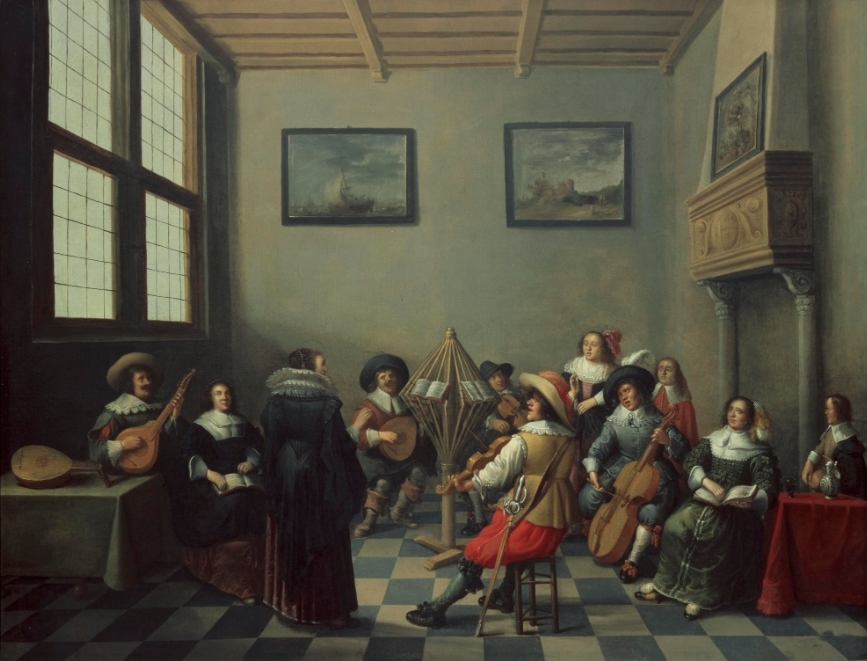
Since music was a movable art, it permeated the domestic environment freely in the hands of guests and family members, who brought musical instruments over the threshold as easily as the chimes of bells sailed through open windows. Musical performance and practice often accompanied social gatherings. Among the public duties of the city organists discussed earlier, they functioned in the private sphere as directors of local collegium musicum. 48 A collegium was a small group, usually of no more than fifteen upper-class men who met with a master once or twice a week.49 One can see such a lofty gathering portrayed by Joost Corneliszoon Droogsloot’s (1586-1666) Interior with a Musical Company (1645, fig. 7). Inside a bright and inviting interior, the assembled crowd gathers around a fantastical music stand. The instruments at play from left to right are a cittern, a lute (with a second lute abandoned on the table), a violin, a viola da gamba, and a second violin, whose player faces one of the three well-attired women. While this painting shows a mixed company, positions in collegia were generally reserved for men. Collegia likely originated in casual family performances, but when the gatherings moved from the domestic to the public space, they excluded women (and men from the lower classes).50 Women were invited to public performances to add a social dimension to the audience, which may account for those present in Droogsloot’s painting.51 With their laps unoccupied by instruments, the women assembled for the performance hold open music books. In the right corner, a woman stands, her lips parted, and hand raised, perhaps indicating a solo performance or her role in keeping time.52
Civic musicians and other professionals who led collegia also found employment opportunities in theaters and in providing private lessons. In the seventeenth century, music lessons were considered a standard facet of the education of middle- and upper-class youth roughly between the ages of eight to fifteen.53 The instruments most often utilized in the domestic setting appear in Jan Miense Molenaer (1610-1668), Self-Portrait with the Artist’s Family (1635, fig. 8). A cloth has been pulled back on the ideal Dutch interior, with rich wood panels and the visually striking black and white tiled floor upon which the harmonious family plays. In use are a variety of string instruments as well as a songbook held by the eldest young woman. The youngest children stand off to the side, still occupied with their toys, indicating that they had not crossed the age threshold for musical instruction. In the Molenaer painting, a virginal is open and on display as a decorative element, but in another example of a musical portrait of David Leeuw and his family (1671, fig. 9), a young woman is occupied playing the stunning keyboard instrument alongside her brother’s viola da gamba. The young woman, dressed in a periwinkle silk dress, plays the keys confidently while meeting the gaze of the audience. The confidence likely comes from rigorous training, as contracts from this period suggest that music lessons would occur daily.54 Jan Pieterszoon Sweelinck (1562- 1621), the composer and organist for the city of Amsterdam, led a collegium and had tutoring contracts with several prominent households in Amsterdam, many of his pupils being young women.55 In a contract dated June 1640, Johannes Hartough, another professional musician and organist in Amsterdam, was employed by Hans Pieters to instruct his two daughters. According to the contract Hartough “will come to their house every day to teach and instruct them [the daughters] in playing the clavecimbel…for a period of one and a half consecutive years.”56 The wording of the Hartough contract stipulated that, by the end of one and a half years, the pupils would have perfected their performances.57
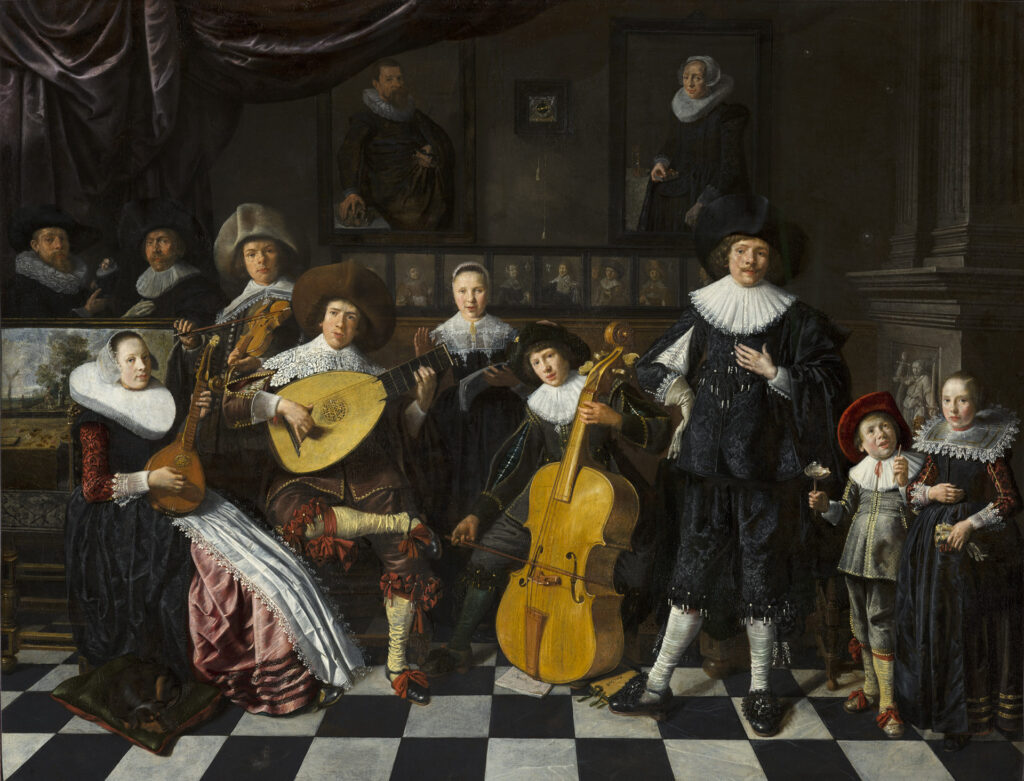
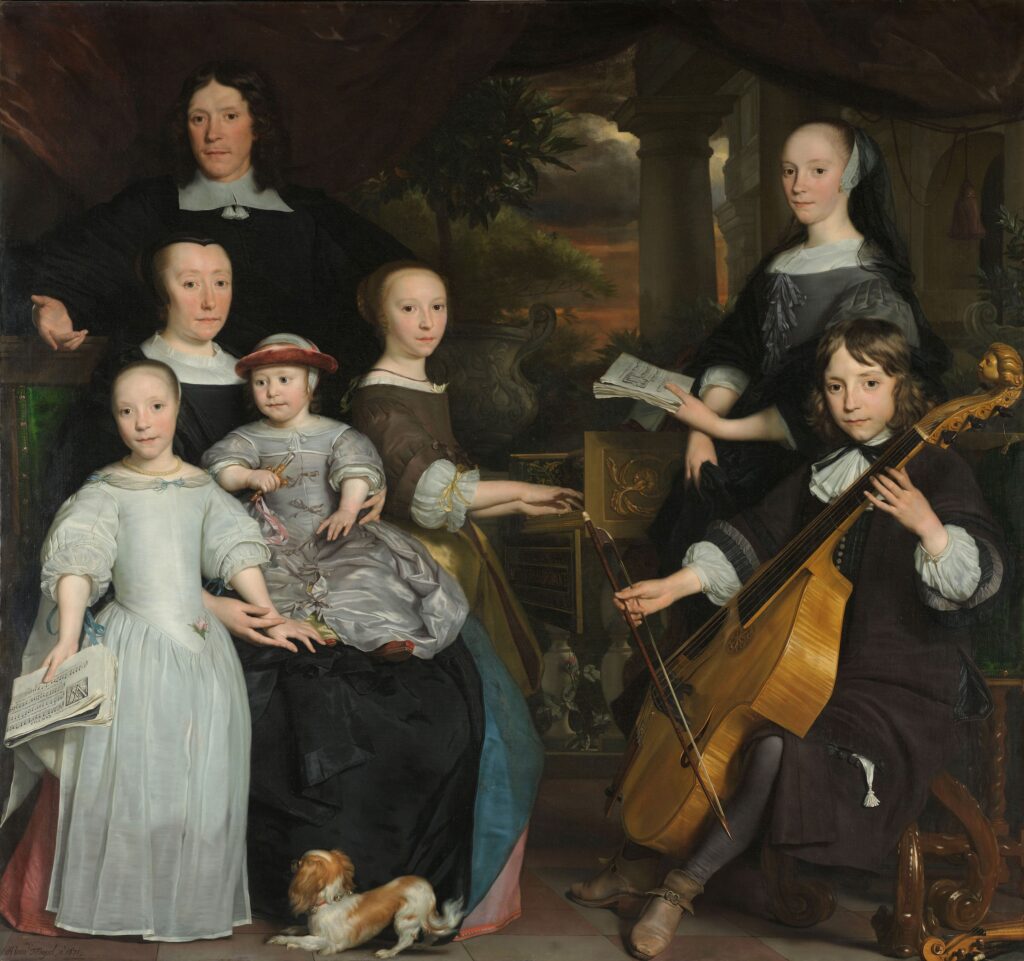
While young men and boys actively engaged in musical practice, they were not encouraged to participate in virginal lessons, as evident in the aforesaid contracts and writings of Constantijn Huygens’.58 In a letter describing his son’s musical education, Huygens references the virginal directly, explaining that while his sons had access to the instrument it was “more suitable for daughters.”59 The sons in both musical family portraits, discussed above, appear to be following this program of instruction. In Molenaer’s musical portrait, where the virginal is unused, the young boys are employed with a lute and a viola da gamba, underpinning a visual gendering of instruments. When the virginal players have company, it is more likely for their masculine companions to distract them from their chords rather than appreciate their technically precise fingering. In Gabriel Metsu’s Man and Woman Seated at a Virginal (1664-1666, fig. 15) the metaphor plays out quite literally, as the young woman is about to exchange her musical notation for a tempting glass of wine. Behind them, the virginal itself comments on the transaction. The inscription on the lid refers to a biblical passage “In thee, O Lord, do I put my trust; never let me be put to confusion,” while the lower lid echoes, “Omnis Spiritus/Laudet Dominium.” The texts speak directly to the burden of morality and propriety the virginal players were expected to carry.
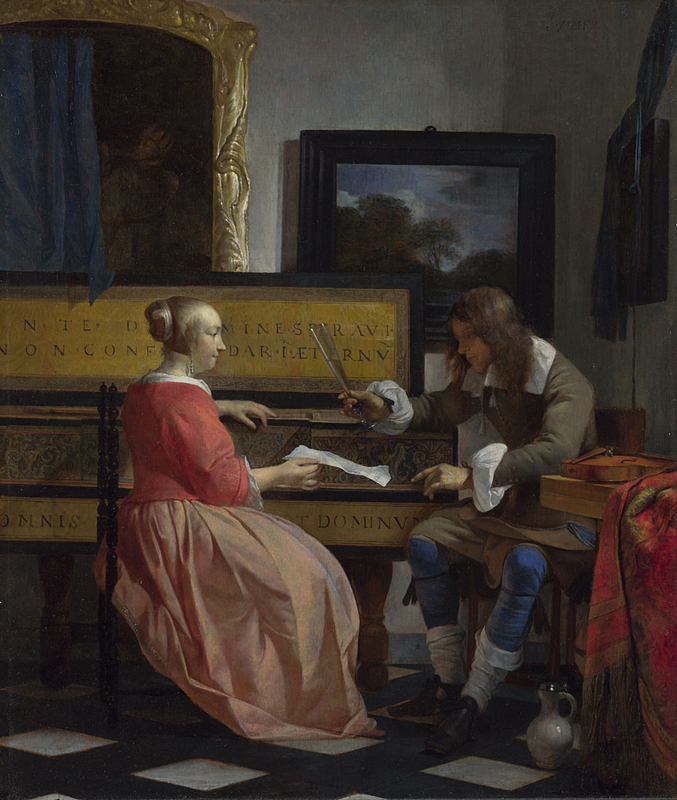
The Virginal and Its Players
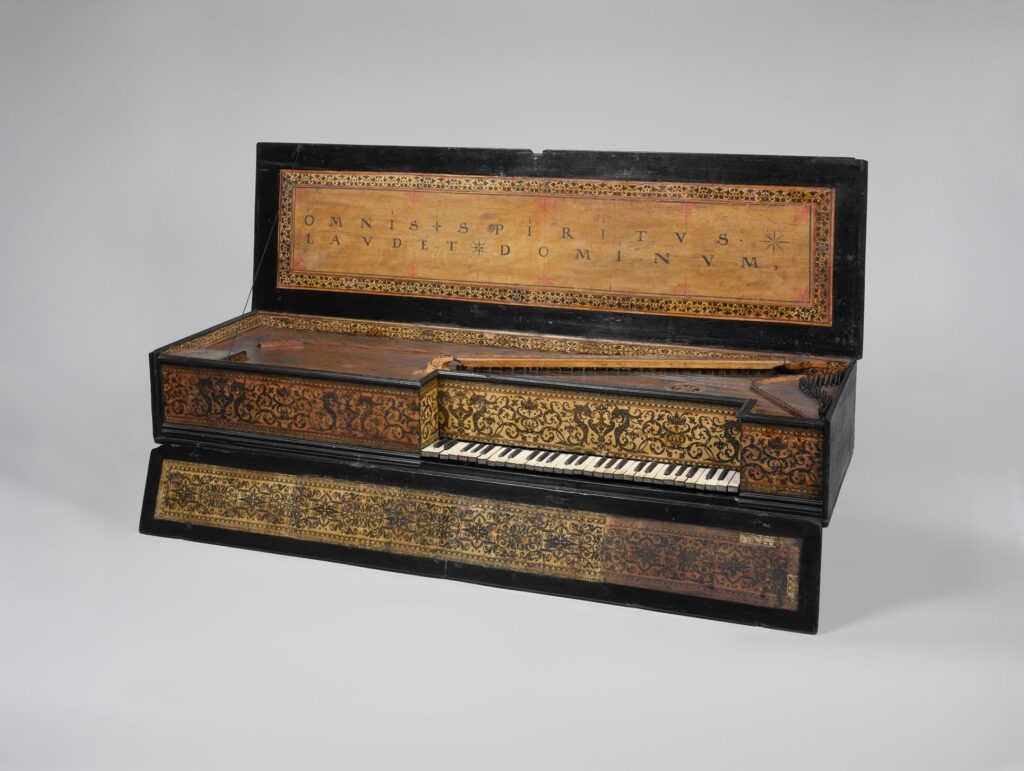
The virginals’ most ubiquitous purpose in the Dutch Republic was as instruments for house music and in the employ of young ladies in music lessons.60 By their very name, virginals evoke a sense of virtuous comportment deemed most suitable for womanhood. The name, in fact, is thought to derive from the Latin term virga, meaning rod, likely in reference to the wooden mechanisms that pluck the strings.61 Virginals’ decorations reflect the moral weight of femininity, as well as the cultural fear of idleness and immorality. Artists and artisans of this period often utilized the virginal soundboard as a surface for landscapes; however, another popular form of decoration was Latin mottoes addressing matters of piety and service to the Lord. These mottoes were popularized by the Rucker’s family of instrument makers based in Antwerp, the mottoes were printed on thin sheets of paper that could quickly be applied to the instrument.62 Using pre-printed paper designs allowed for a quicker and (slightly) more economical means of production. Mottoes related to a wide range of topics including classical Greek literature and contemporary Dutch riddles, but in Thomas McGeary’s inventory of early modern instruments, moralizing mottoes were the most abundant.63 These moral phrases upon the most visible parts of the virginal often dedicated its musical performance to a higher power:
SIC TRANSIT GLORIA MVNDI (Thus Passes The Glory of the World.) (fig. 10)
OMNIS SPIRITUS/LAUDET DOMINUM (Let every spirit praise the Lord) (fig. 2)
The exterior decoration amplified the music’s attachment to strict Calvinist morals and thus made its music the product of a lady’s worthwhile time and devotion.
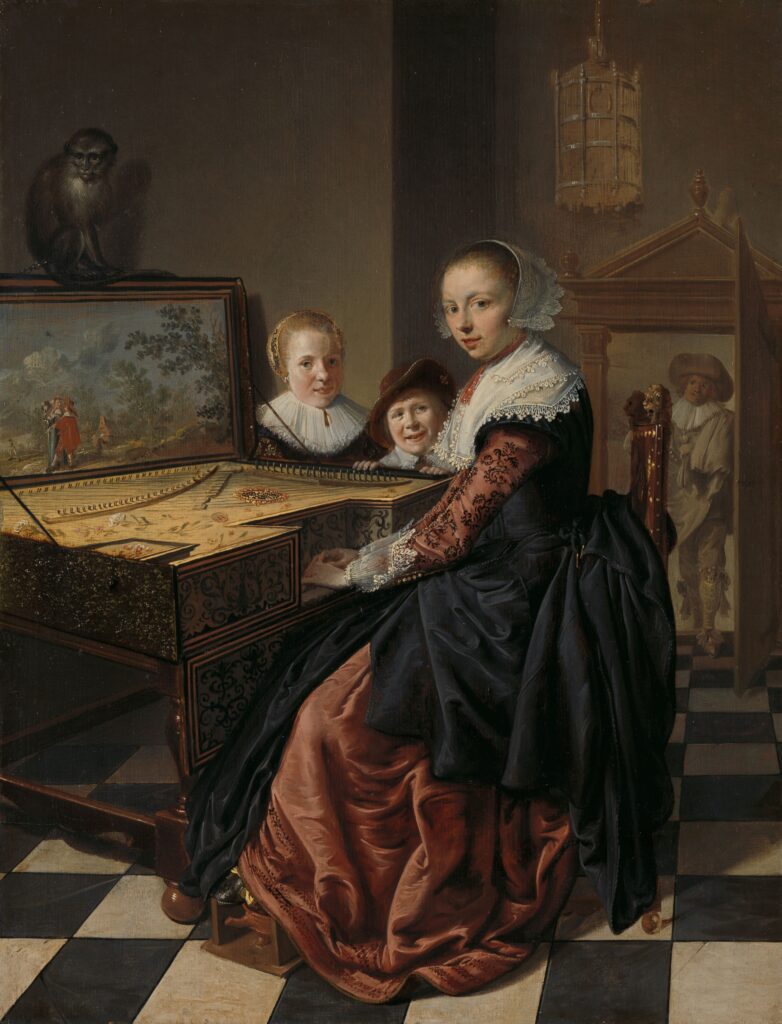
The time spent developing the virginal skillset cultivated deft hands, beautifully captured in Molenaer’s Woman at the Virginal (1630, fig. 11). A lady in a rich, lace-trimmed garment is seated at a distinctive virginal. While the bird cage and chained monkey are signs of docility, the interior of the instrument’s lid opens to reveal a pastoral escape.64 The underside surface is decorated with a couple strolling through a landscape, a similar scene is depicted on the interior lid of a clavichord in the Rijksmuseum collection (1650, fig. 12). This subject is possibly an homage to the amorously-themed songs found in many secular songbooks of the time.65 As one’s eyes drift from the rolling hills of the landscape, they will find the source of the scene’s accompaniment. The musician’s hands (fig. 11, detail), reveal specific musical cues. The relatively firm placement of her left hand hints at the sounds of a chord. Her right wrist’s delicate, outward turn suggests a downward run with the melody.66 One did not use all fingers while playing the virginal; their thumbs were often unengaged, which caused the player to turn their wrist while playing runs of notes.67 The knowledge of the techniques and their ensuing sounds described above would not be accessible to every viewer. Only those trained in the virginal could connect the movement of the fingers to the sound, resulting in a private concert for those visually and aurally astute to attend. In the Dutch seventeenth century this special audience would have been significantly populated by women.
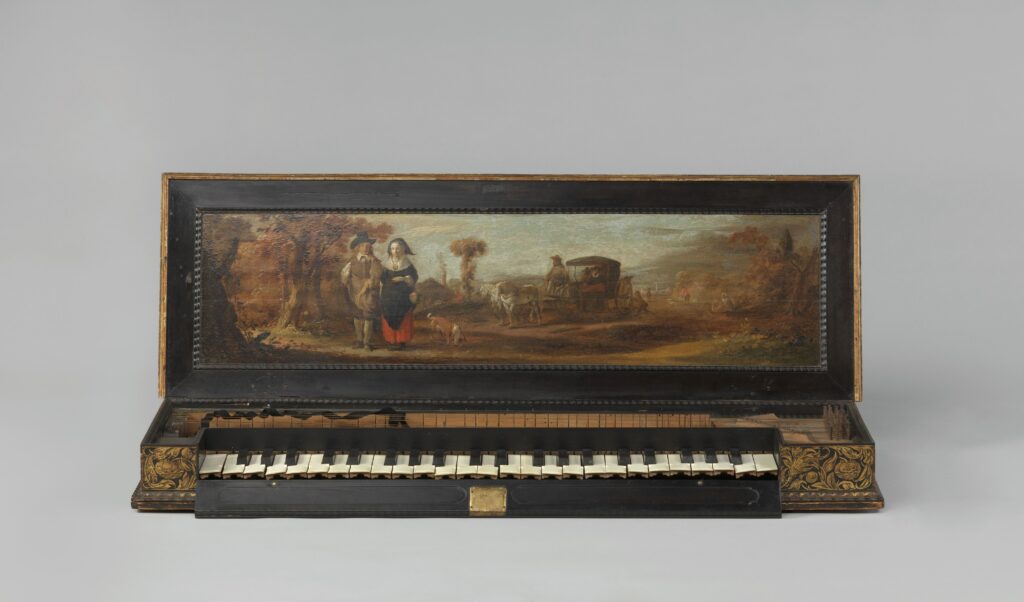
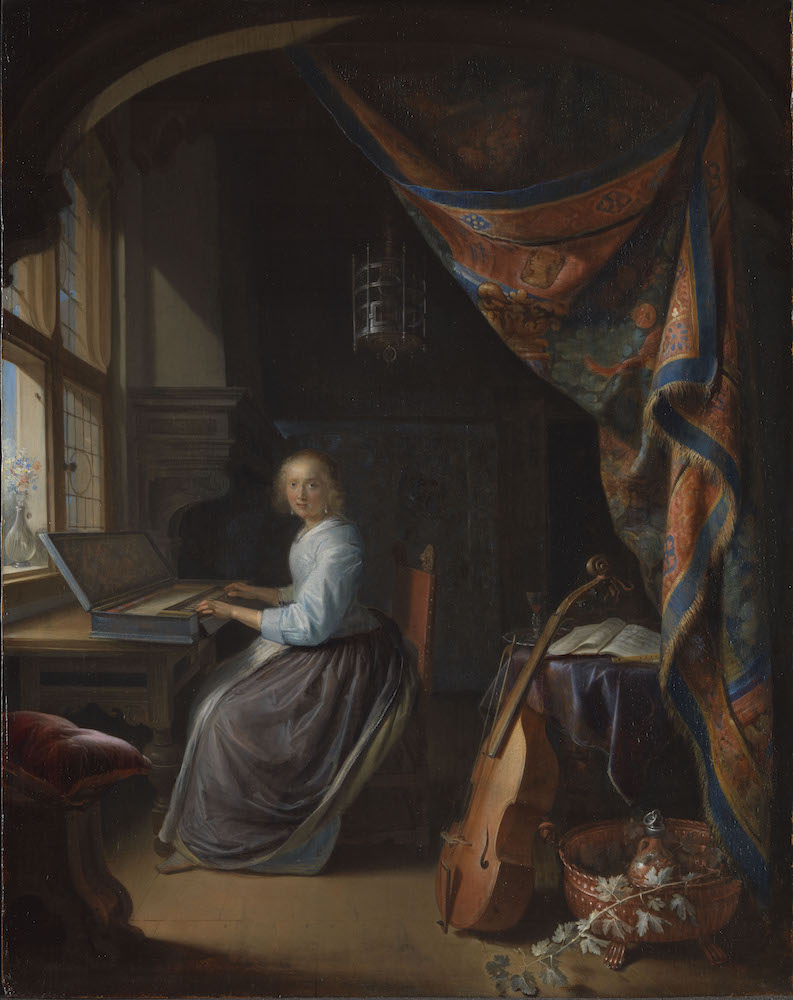
Preserved records of high-ranking Dutch women, Béatrix de Cusance, the Duchess of Lorraine (1614-1663), and Anna Roemer Visscher (1583-1651), reference the respect commended by their musical proficiency. Anna’s family homes, both in Amsterdam and a castle in Muiden, were often the setting of cultural get-togethers hosted by her father, merchant and poet Roemer Visscher (1547 – 1620).68 Anna is known to have played the flute, lute, and viola da gamba, and composed music. Regarding Béatrix de Cusance , Constantijn Huygens corresponded at length with her, and music was often included in their repartee. In one letter in 1659, she asked for a duet with her on the keyboard and him on strings.69 In many virginal paintings, such as Gerrit Dou’s A Woman Playing a Clavichord (ca. 1665, fig. 13), a viola da gamba appears as if to suggest such a duet could occur within the space. Notice the formulaic structure of a music painting, with all elements arranged around the young woman echoing the visual trend throughout the paintings in this article. In this intimate portrayal, Dou’s palpable textures draw the viewer’s eye to a viola da gamba abandoned in the right corner of the frame. The gamba’s intentional silence stirs something in the viewer to step into her world, a cavernous yet intimate domestic stage where many of the aforementioned female amateurs would feel at home. Due to the circumstances outlined in this paper, the audience should no longer be assumed to be masculine, tempted to woo the musician by her beckoning gaze. A feminine viewer would have been equally moved by this subject, and perhaps felt a deeper connection given the domestic setting.
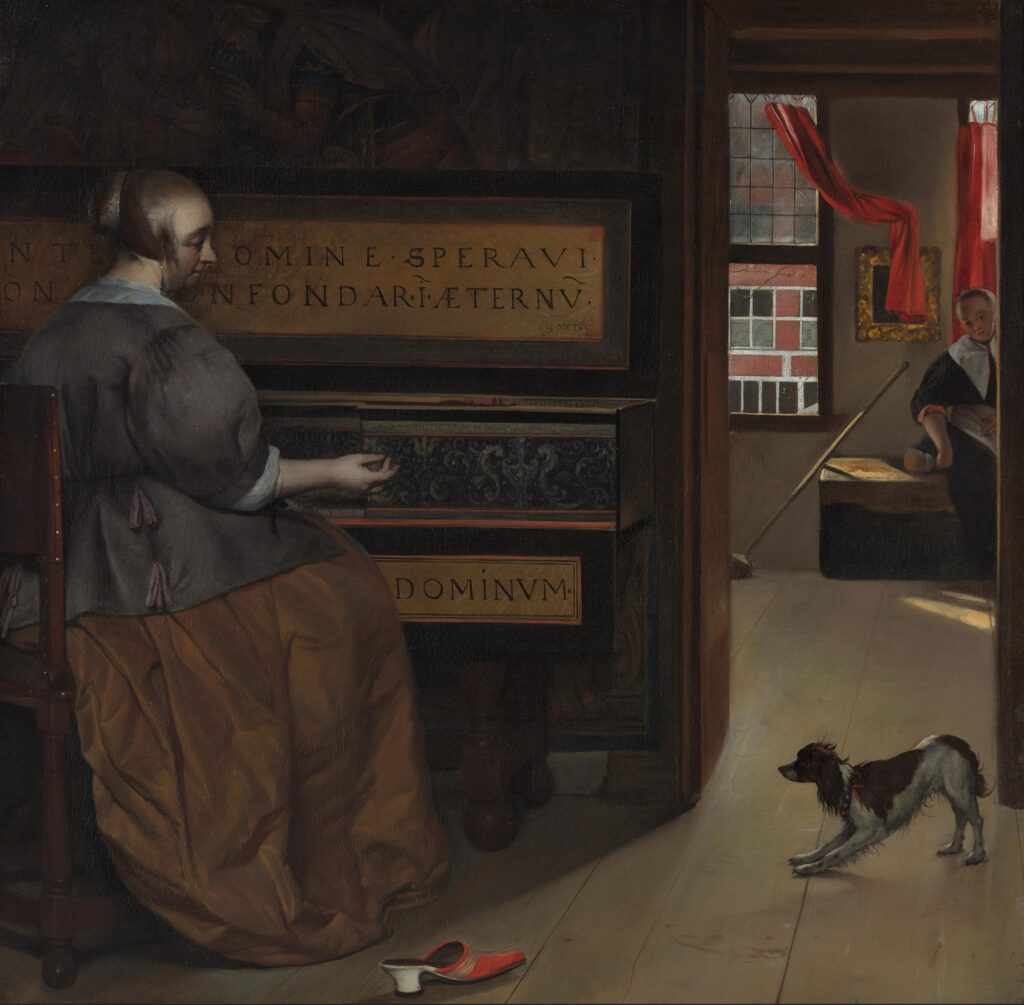
The domestic venue for these musical performances carries social significance, particularly as the sphere of feminine influence in the seventeenth century. In paintings, female musicians are seated, or standing, in lusciously decorated rooms. Gabriël Metsu (1629–1667), likewise, places his player in Lady at a Virginal (ca. 1660-67, fig. 14) on the second story of a home, tucked away from the window-lined front room where another woman, possibly the maid, is resting. Once more, the music room is darker to give a sense of separateness, which was common for houses at this time. While the rooms in paintings reveal very little of the reality of a seventeenth-century floor plan, some archival records fill in the gaps in our knowledge. In the 1651 inventory of a medical educator and Doctor from Leiden, Johan van Beverwijck (1594-1647), there is a record of a Kelder Kamer (Cellar Room), a subterranean living space or a room on the ground floor where there was an entrance to the basement, which functioned as a boudoir or a private room for women of the house.70 The inventory reveals that this room contained a harpsichord “with a pedestal for ‘daughters’ and ‘a lady’s chair’ upholstered in blue damask.”71 The furniture in the inventory suggests a limited monochromatic blue palette to coordinate with the blue-ground gilt leather walls; this careful color coordination originates in the French adaptation of Renaissance notions of architectural harmony.72 The setting of Vermeer’s virginal player (fig. 1) is reminiscent of this description, with the dim lighting and heavy curtains adding to a subterranean and separated feeling. These private spaces would have determined the soundscapes of different members of the household. As referenced earlier in this paper, the front of the Dutch home was considered a more public space, a place for visitors and conducting business, while the recessed areas of the home acted as intimate spaces for family and close friends.73 While not dark, many compositions featuring female musicians – including the ones just discussed – have a sense of interiority, as though the viewer has walked through the home to attend a concert.
Conclusion
The ideal of Dutch womanhood was being crafted in the seventeenth century, and no small part of that identity included their ties to appropriate music. Anxieties of modesty and morality were translated through paintings of women and music. Women dancing to the public tunes of the bagpipe were depicted as lost and prone to sin. At the same time, domestic music fended off voluptuous associations with quiet rooms and decorative mottoes dedicating the work of song to the Lord. A virtuous woman would not have sought out the voluptuous urban soundscape but would have most likely made music in the privacy of their homes, on virginals.
Therefore, the choice to include virginals in paintings must have been a conscious one to attract women for whom the instrument was part of childhood training or daily routine. Due to insufficient training, the appreciation of upper-class men in the Dutch Republic for imagery of virginal players remained primarily on an aesthetic level.Limited access is perhaps a reason why so many male painters deliberately hide or obscure the fingering of their virginal players. These artists likely had no trained family member to observe and it would not have been proper to study a young woman to whom they were not related.74 Upper and middle-class women in the Dutch Republic at this time would have enjoyed virginal paintings at a different level than their male counterparts. Those who spent the majority of their time within the household interior would have become used to muted civic noise and heightened domestic noise, and, for many young women, this would have included the sounds of the virginal.
While the overwhelmingly female musicians featured in Dutch musical paintings have often been minimized in the field of art history, they represent a class of high-ranking amateurs who exercised control over the domestic realm to which they had been relegated. By depicting expensive and highly decorated instruments, such as the virginal, early modern Dutch artists were appealing to the sounds familiar to wealthy female patrons and viewers who may have been drawn to these musical paintings which embodied their lived experience.
Notes
1. Edward L. Kottick, A History of the Harpsichord (Bloomington and Indianapolis: Indiana University Press, 2016), 108.
2. Timothy de Paepe et al., Antwerp, City of Harpsichords: Two Centuries of Exceptional Musical Instruments from the Museum Vleeshuis, Sound of the City (Wommelgem, Belgium: BAI, 2018), 15
3. Helen H. Metzelaar, From Private to Public Spheres: Exploring Women’s Role in Dutch Musical Life from c. 1700 to c. 1800 and Three Case Studies, Muziekhistorische Monografieën 16 (Utrecht: Koninklijke Verenigung voor Nederlandse Muziekgeschiedenis, 1999). 35.
4. Grant O’Brien, Ruckers: A Harpsichord and Virginal Building Tradition, Cambridge Musical Texts and Monographs (Cambridge: Cambridge University Press, 2008), 72 -74.
5. Alec Hodsdon and Cecil Clutton, “Defining the Virginal,” The Musical Times 88, no. 1251 (May 1947), 154.
6. Hodsdon and Clutton, “Defining the Virginal,” 153-154.
7. Most Virginal keyboards have been enlarged from the original compass of C/E-c3 (45-keys) range to a 45-note range; Hodsdon and Clutton, “Defining the Virginal,”154; O’Brien, Ruckers, 72; To fully convey the sound produced by this instrument, a brief recording of a muselar virginal from the Brussels Musical Instruments Museum, updated to playing condition: Jan Pieterszoon Sweelinck, “Capriccio a1, SwWV 281” performed by Bob van Asperen, from the album Virginaal, published by the Musical Instruments Museum of Brussels in 2001. https://on.soundcloud.com/VfJj
8. Magda Kyrova, “Music in Seventeenth-Century Dutch Painting,” in The Hoogsteder Exhibition of Music & Painting in the Golden Age, by Edwin Buijsen et al. (Hague : Zwolle: Hoogsteder & Hoogsteder ; Waanders, 1994), 31–61.
9. Marjorie E. Wieseman, “Inviting Duets,” in Vermeer and the Masters of Genre Painting: Inspiration and Rivalry, ed. Adriaan E. Waiboer et al. (Dublin : Washington : National Gallery of Art ; Paris : Musée du Louvre: National Gallery of Ireland, 2017), 135–39. Deborah Howard and Laura Moretti have made significant strides in examining the interaction of sound and space in Renaissance Venice see Sound and Space in Renaissance Venice: Architecture, Music, Acoustics. Yale University Press, 2009.
10. Ian D. Biddle and Kirsten Gibson, eds., Cultural Histories of Noise, Sound and Listening in Europe, 1300-1918 (London New York: Routledge Taylor and Francis Group, 2017), 1;
11. The historiography and state of the field in “musical iconography” is fully explored in the 2023 publication by Antonio Baldassarre, “Navigating the Maze: Challenges to Current Music Iconography Research,” wherein he claims “music iconography has not relieved musicology of specialisation but – ironically – has rather developed itself into a highly specialised (sic) field of research…” 28.
12. For my purposes ‘gender’ is examined as a performative social construction. My definition best aligns with that of Judith Butler, wherein gender identity consists of a stylized repetition of acts, rather than a seamless identity. The gender identities in this article are products of gendered actions Dutch seventeenth century people were compelled to perform. Judith Butler, “Performative Acts and Gender Constitution: An Essay in Phenomenology and Feminist Theory,” Theatre Journal 40, no. 4 (1988): 520.
13. For my purposes, music refers to composed and controlled notes made by instrument or voices. Noise refers to unintentional byproducts of activity (cartwheels, footsteps, doors opening and closing, etc.). Sound is the general term for the aural elements of the surrounding environment.
14. Elizabeth A. Honig, “The Space of Gender in Seventeenth-Century Dutch Painting,” in Looking at Seventeenth-Century Dutch Art: Realism Reconsidered, ed. Wayne Franits (Cambridge; New York: Cambridge University Press, 1998), 245-61.
15. Calvinism is a branch of Protestantism based on the teachings of John Calvin (1509-1564), the theologian and Reformation pastor.; Pieter Fischer, Music in Paintings of the Low Countries in the 16th and 17th Centuries (Amsterdam: Swets & Zeitlinger, 1975), 65; Natascha Veldhorst, “Pharmacy for the Body and Soul: Dutch Songbooks in the Seventeenth Century,” Early Music History 27 (October 2008), 220.
16. Magda Kyrova, “The Public and the Private Space in Sixteenth- and Seventeenth- Century Amsterdam,” in The Public and Private in Dutch Culture of the Golden Age, ed. Arthur K. Wheelock, Adele F. Seeff, and R.E. Kitemaker (Newark [Del.]: London: University of Delaware Press; Associated University Presses, 2000). 39, 44.
17. Edwin Buijsen, “Music in the Age of Vermeer,” in Dutch Society in the Age of Vermeer, ed. Donald Haks, Marie Christine van der Sman, and Haags Historisch Museum ([The Hague] : Zwolle: Hague Historical Museum ; Waanders Publishers, 1996), 106
18. Ibid., 106.
19. Adriaan E. Waiboer, “A Clean Competition: Some Hypotheses on Vermeer’s Lost ‘Gentleman Washing His Hands,’” in Aemulatio: Imitation, Emulation and Invention in Netherlandish Art from 1500 to 1800: Essays in Honor of Eric Jan Sluijter, ed. Anton W. A. Boschloo et al. (Zwolle: Waanders, 2011), 407.
20. Buijsen, “Music in the Age of Vermeer,” 119.
21. This essay is based on a presentation given at the Renaissance Society of America Conference in Dublin, 2022. The research is based on my ongoing dissertation, “Through the Ears to the Soul: Female musicians in Dutch Seventeenth-Century Paintings.”
22. Thomas McGeary, “Harpsichord Mottoes,” Journal of the American Musical Instrument Society 7, 1981, 12 – 13.
23. When complimented on his performance, Huygens was noted to have commented “…in the country of the blind, the one-eyed man is King.”; Grijp, “Dutch Music of the Golden Age.” 63; Kyrova, “The Public and the Private Space in Sixteenth- and Seventeenth-Century Amsterdam.” 32.
24. Many cities in the Netherlands and in centers across Europe employed multiple civic musicians including an organist, a carillonneur (the player of a carillon, bells in a tower played with a keyboard), tower- guard trumpeters, and horn players). In a large city such as Amsterdam, the civic musicians would provide daily musical interludes; in most cities of the Dutch Republic, these musicians would play at processions, fairs, and provide table music for official dinners; Price, Culture and Society in the Dutch Republic during the 17th Century, 112; Kyrova, “The Public and the Private Space in Sixteenth- and Seventeenth- Century Amsterdam,” 32, 33.
25. Mia M. Mochizuki, The Netherlandish Image after Iconoclasm, 1566-1672: Material Religion in the Dutch Golden Age (Burlington, VT: Ashgate, 2008).
26. Kyrova, “The Public and the Private Space in Sixteenth- and Seventeenth- Century Amsterdam,” 32, 35.
27. Maarten Hell, De Amsterdamse herberg 1450-1800: geestrijk centrum van het openbare leven (Nijmegen: Uitgeverij Vantilt, 2017), 246; Buijsen “Music in the Age of Vermeer,” 110.
28. Hell, De Amsterdamse herberg 1450-1800, 244.
29. Ibid., 244.
30. The viol belongs to the violin family but is larger and requires more pressure on the bow; a rommelpots(or thunder pot) is a ceramic pot fitted with a skin and a stick in the center which a player would move about to create sound; A hurdy gurdy is a hand-cranked keyboard instrument.
31. Buijsen, “Music in the Age of Vermeer,” 110.
32. Vanhaelen, Angela, The Moving Statues of Seventeenth-Century Amsterdam: Automata, Waxworks, Fountains, Labyrinths, University Park, Pennsylvania: The Pennsylvania State University Press, 2022, 47-48.
33. Niall Atkinson, “Thinking through Noise, Building toward Silence: Creating a Sound Mind and Sound Architecture in the Premodern City,” Grey Room 60 (July 1, 2015), 30.
34. Richard Leppert, The Sight of Sound: Music, Representation, and the History of the Body, 1995, 80.
35. Flora Dennis, “Sound and Domestic Space in Fifteenth- and Sixteenth-Century Italy,” Studies in the Decorative Arts 16, no. 1 (2008), 19.
36. John Loughman and John Michael Montias, Public and Private Spaces: Works of Art in Seventeenth-Century Dutch Houses (Zwolle: Waanders, 2000), 27.
37. Loughman and Montias, Public and Private Spaces, 29.
38. Willem Goeree, D’Algemeene Bouwkunde, 1681, pp. 135–136.
39. Michelle Moseley-Christian, “Seventeenth-Century Pronk Poppenhuisen: Domestic Space and the Ritual Function of Dutch Dollhouses for Women,” Home Cultures 7, no. 3 (November 1, 2010): 352-3.
40. William Temple, The Works of Sir William Temple, Bart. In Two Volumes to Which Is Prefix’d Some Account of the Life and Writings of the Author. Of 2; Volume 2 (Creative Media Partners, LLC, 2018), 472- 73.
41. Honig, “The Space of Gender in Seventeenth-Century Dutch Painting,” 258.
42. Ibid., 245–68.
43. An estimated 30-40% of the Republic’s inhabitants were literate, data … showed that in 1650, 50.8% of the Amsterdam-born brides were able to write their name; Wayne E. Franits, Paragons of Virtue: Women and Domesticity in Seventeenth-Century Dutch Art, 1, (Cambridge: Cambridge Univ. Press, 1995), 19; In an interview Jan Six X, a descendant of Amsterdam cultural figure and burgermeester (mayor) Jan Six (1618-1700), recalled when people called in the 1970s they referred to it as the home of Madame Six.
44. Judith Noorman and Frans Grijzenhout, “Lady of the House. The Household, Art and Memoria in the Dutch Republic,” in Everything Begins at Home: The Early Modern Household I: Materiality, 2018.
45. Ibid.
46. Ibid.
47. Pieter Roelofs, “Johannes Vermeer (Delft 1632-1675) Modestly Masterful,” in Vermeer, ed. Gregor J. M. Weber, Pieter Roelofs, and Taco Dibbits (New York: Thames & Hudson, 2023), 33; Judith Noorman and Robbert Jan van der Maal, Het unieke memorieboek van Maria van Nesse (1588-1650), 2022, 129-147.
48. Kyrova, “The Public and the Private,” 32.
49. Collegia formed all across the Netherlands in the sixteenth and seventeenth centuries Arnhem (1591) Utrecht (1631) Groningen (1638) and Hoorn (1684) they varied in size, funding, and stamina (some lasted decades other weeks); Kyrova, “The Public and the Private,” 32, 34.
50. Class is a significant factor to consider in the experience of music, noise and sound. Women and men from lower classes would have been exposed to a very different soundscape than the upper-classes;Metzelaar, From Private to Public Spheres, 45-46
51. Ibid.,, 46.
52. The St. Caecillia collegium in Arnhem had three female members, but their invitation and roles were thought to be symbolic: Metzelaar, From Private to Public Spheres, 46-46.
53. J. W. J. Burgers, Helene Reid, and Susan Pond, The Lute in the Dutch Golden Age: Musical Culture in the Netherlands 1580-1670, Amsterdam Studies in the Dutch Golden Age (Amsterdam: Amsterdam University Press, 2013), 46.
54. Ibid., 46.
55. Buijsen, “Music in the Age of Vermeer,” 112-113.
56. In seventeenth-century Dutch, both harpsichords and virginals were referred to as “clavecijn”, “clavesigngl” or “clavecimbel” therefore it is difficult to identify the exact instrument used in this case Voorbericht van H.E. van Gelder, Nederlandsch Muziekleven 1600-1800, accessed August 13, 2023, 15; Metzelaar, From Private to Public Spheres, 34.
57. GAA notarial archive 731, fol 640, Pieter Carelsz, 4 June 1640, Voorbericht van H.E. van Gelder, Nederlandsch Muziekleven 1600-1800, accessed August 13, 2023, 15.
58. The musical education of upper-class men occurred within the home as well with hired music masters, but more often centered around string instruments such as the lute or viola da gamba. Huygens also purchased a Ruckers harpsichord later in his life; Rudolf Rasch, ed., Driehonderd brieven over muziek van, aan en rond Constantijn Huygens (Hilversum: Verloren, 2007), 989 – 990; Marjorie E. Wieseman, Vermeer and Music: The Art of Love and Leisure (London: National Gallery Company, 2013,) 15.
59. Burgers, The Lute in the Golden Age, 42.
60. O’Brien, Ruckers, 72.
61. de Paepe et al., Antwerp, City of Harpsichords, 16.
62. Leppert, The Theme of Music in Flemish Paintings of the Seventeenth Century, 132.
63. Thomas McGeary, “Harpsichord Mottoes,” Journal of the American Musical Instrument Society 7, 1981, 5–35.
64. Jessica Sternbach, “The Pastoral Paradox: Encountering the Pastoral in Seventeenth-century Dutch Interiors,” Seminar Sessions at Renaissance Society of America Virtual Conference, April 20, 2021.
65. Many songbooks were printed for the purposes of courtship, and amorous themes prevailed, Die Niewen Lust Hof’s (1607) first page includes a dedication poem with a blank space for the intended recipient. Songbooks often had a mix of Religious material and even Emblem texts. Songs are often contrafacta, meaning song texts written to pre-existing tunes. For Dutch songbooks, these tunes are often French, sometimes Italian. Louis Peter Grijp, “Apollo’s Gifts: Dutch Songbooks for the Urban Youth of the 18th Century,” in Music and the City: Musical Cultures and Urban Societies in the Southern Netherlands and Beyond, c. 1650-1800, ed. Stefanie Beghein, B. Blondé, and Eugeen Schreurs (Leuven: Leuven University Press, 2013), 162; Natascha Veldhorst, “Pharmacy for the Body and Soul: Dutch Songbooks in the Seventeenth Century,” Early Music History 27 (October 2008), 227.
66. Most of my knowledge of keyboard techniques derives from conversations with Tamar Hestrin Grader, a trained musician and researcher from Amsterdam. Renowned harpsichord builder Allan Winkler provided additional information during my time as a visiting scholar at the Center for Netherlandish Art, made possible by the Brenninkmeyer Family.
67. Timothy de Paepe et al., Antwerp, City of Harpsichords: Two Centuries of Exceptional Musical Instruments from the Museum Vleeshuis, Sound of the City (Wommelgem, Belgium: BAI, 2018), 16.
68. Metzelaar, From Private to Public Spheres, 32.
69. Buijsen, “Music in the Age of Vermeer” 119.
70. John Loughman and John Michael Montias, Public and Private Spaces, 78.
71. Ibid., 78
72. Loughman and Montias, Public and Private Spaces, 78.
73. Ibid., 78.
74. Ironically these barriers are similar to those women faced trying to become professional painters.

